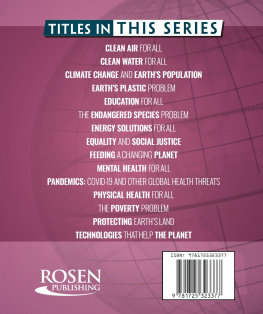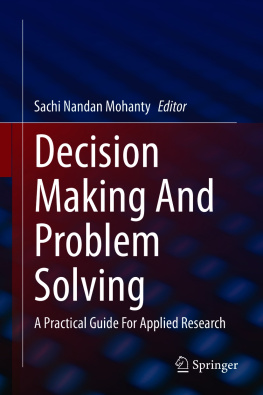
Published in 2020 by The Rosen Publishing Group, Inc.
29 East 21st Street, New York, NY 10010
Copyright 2020 by The Rosen Publishing Group, Inc.
All rights reserved. No part of this book may be reproduced in any form without permission in writing from the publisher, except by a reviewer.
Editor: Elizabeth Krajnik
Designer: Michael Flynn
Photo Credits: Cover Jose Luis Pelaez Inc/DigitalVision/Getty Images; cover, pp..
Cataloging-in-Publication Data
Names: Morlock, Rachael.
Title: Overcoming obstacles: identifying problems / Rachael Morlock.
Description: New York: PowerKids Press, 2020. | Series: Spotlight on social and emotional learning | Includes glossary and index.
Identifiers: ISBN 9781725306790 (pbk.) | ISBN 9781725306820 (library bound) | ISBN 9781725306806 (6pack)
Subjects: LCSH: Problem solving in children--Juvenile literature. | Interpersonal relations--Juvenile literature. |
Decision making in children--Juvenile literature. | Social skills in children--Juvenile literature.
Classification: LCC BF723.P8 M675 2020 | DDC 153.43--dc23
Manufactured in the United States of America
CPSIA Compliance Information: Batch #CWPK20. For further information contact Rosen Publishing, New York, New York at 1-800-237-9932.
Contents
CHAPTER ONE
WHATS THE PROBLEM?
People use problem solving in many areas of their life. Problem solving is a social skill that helps you build stronger skill that can help you understand how things work together.


Gitanjali Rao was 11 years old when she created a quick and easy way to test water for lead, which is a poisonous heavy metal. Her problemsolving invention helps prevent people from drinking water.
It takes practice, but problem solving is a skill you already use every day for large and small problems. However, to solve a problem, you must first identify what the problem is. From there, you can follow steps to solve your problem. Exercising our problem-solving skills helps us lead happier and healthier lives.
CHAPTER TWO
HOW TO SOLVE PROBLEMS
How do you know if you have a problem? If theres a gap between what is and what should be, then theres a problem. Sometimes problems are personal. Then the gap lies between what you have and what you want. Once you recognize theres a problem, you can begin the problem-solving process.
The first step is identifying the problem. It may seem and think about the possible consequences, or results, of each of your options. The fourth step is choosing a solution and trying it out. The fifth and final step is to reflect, or look back, on the results. If you didnt like the result of your solution, you may need to repeat steps four and five.

You can practice the problem-solving process with games, puzzles, and projects.
CHAPTER THREE
IDENTIFYING PROBLEMS
The first step of problem solving is often overlooked. If youre in a hurry to find a solution, you might want to jump ahead and begin trying different options. Unfortunately, this can lead to even more problems! Before you look for a solution, its important to understand and identify your problem.
Take the time to get to the root of your problem. Otherwise, you might work on solving the wrong problem by focusing on a instead of the true cause. This usually happens when people assume, or think they know but dont, that they understand a problem. Instead of assuming, take a scientific approach. Use observations and facts to identify the problem. This will help you clearly understand what needs to be done. As you work to identify the problem, there are a number of tips and methods that can help.

Scientist and mathematician Albert Einstein said, If I were given one hour to save the planet, I would spend 59 minutes defining the problem and one minute resolving it.
CHAPTER FOUR
KEEP CALM
How do you feel when faced with a problem? Maybe youre having trouble learning a new swimming stroke or you keep forgetting to bring your lunch to school. Maybe youre having trouble understanding a math problem or you had a disagreement with a friend. A lot of problems are tied to your emotions. They can leave you feeling .


Meditation can be as simple as paying attention to your breathing. Close your eyes and slowly breathe in and out five times. Do you feel calmer and more focused?
Its easier to think clearly when youre calm. Try taking deep breaths or to work through your frustration. Find a quiet place or just take some quiet time to yourself so you can listen to your thoughts. If you feel very upset, you might need to take a break before identifying your problem.
When youre calm and ready to identify your problem, focus on the facts. Try not to blame others. Instead, think about your own actions, which are the only things you can control.
CHAPTER FIVE
FINDING THE WORDS
In order to be calm, you may need to acknowledge, or recognize and accept, the feelings youre having. This is especially true if you have a social problem, like a disagreement with a friend or family member. Acknowledging your feelings takes self-awareness, or knowledge of your thoughts and emotions.
It can be hard to put your feelings into words. The more you know about emotions, the easier it will be to identify them. When youve acknowledged your feelings, you can try to understand what caused you to have them. Try to fill in the sentence, I feel ____ when _____ happens.
Acknowledging your feelings brings you one step closer to identifying the problem. Youve identified a problem when you can put it into words. Youll need to the problem as clearly as you can.

When youre identifying a problem, writing it down or saying it out loud can help.
CHAPTER SIX
INVESTIGATE
Your job now is to act like a problem-solving detective. Its time to investigate whats happening. Investigating means carefully looking into all parts of your situation to find and understand the problem.
Use the question wordswho, what, where, when, why, and howas a starting point for thinking about the problem. How do you know theres a problem? Whos involved in, or connected to, the problem? Whats happening? Whens it happening? Wheres it happening? Whys it happening?
Lets say that you missed the bus again. Missing the bus is a problem, but investigating might help you realize that the problem is actually a symptom of a different problemyou dont have enough time to get ready in the morning. Identifying the problem correctly can lead you to the best solutions.
Next page
























